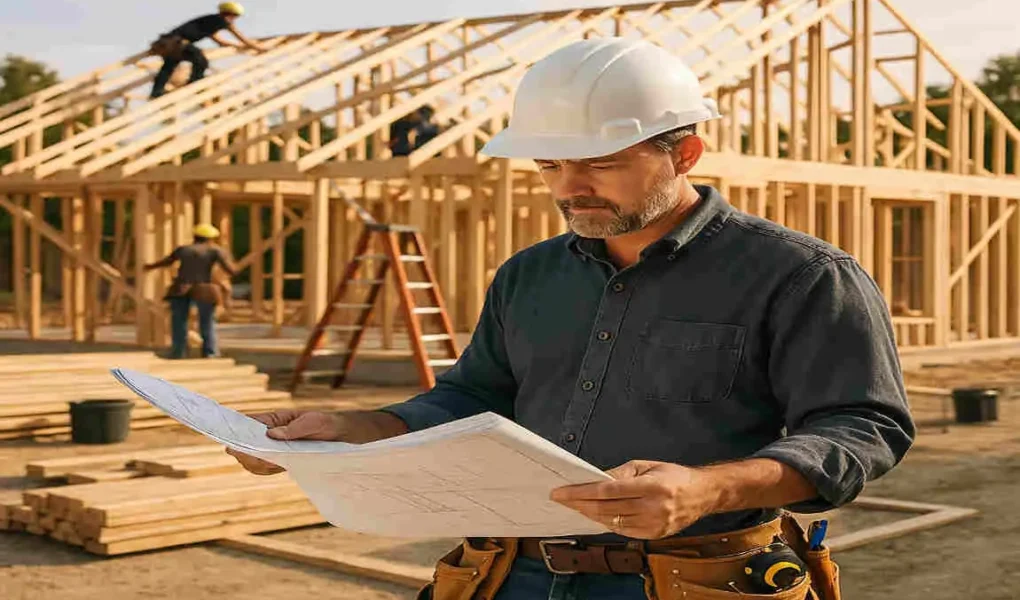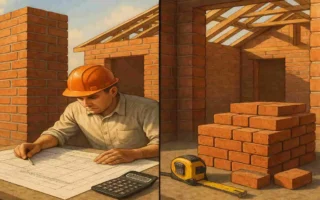Have you ever wondered who’s really in charge when a new house goes up in your neighborhood? Many people assume architects design everything and builders follow blueprints, but the reality is far more nuanced. The person orchestrating this complex symphony of construction is often a general contractor—a professional who might be the most essential player you’ve never fully understood.
Building a house isn’t just about hammering nails and pouring concrete. It’s a carefully choreographed dance involving dozens of specialists, thousands of decisions, and hundreds of thousands of dollars. Whether you’re a first-time homeowner dreaming of your perfect space or a developer looking to maximize your investment, understanding how general contractors work can save you time, money, and countless headaches.
Can a General Contractor Build a House?

Understanding What a General Contractor Really Does
Let’s start with the basics. A general contractor (GC) is essentially the conductor of your construction orchestra. They’re licensed professionals who manage the entire building process, from breaking ground to handing over the keys. Unlike specialists who focus on one trade, GCs see the big picture and coordinate all the moving parts.
Here’s where things get interesting. While architects create the vision and draw the plans, general contractors bring those plans to life. They’re not typically swinging hammers themselves—instead, they’re managing the people who do. Think of them as project managers with hard hats, combining business acumen with construction expertise.
The distinction between different construction professionals matters more than you might think. Builders often refer to companies that both develop and construct homes, sometimes employing their own crews. Architects design structures but rarely manage construction. Subcontractors are the specialists—electricians, plumbers, framers—who perform specific tasks under the GC’s direction.
When GCs Build From Scratch
General contractors absolutely can build houses from the ground up. In fact, this is their bread and butter. When you hire a GC for new construction, they typically handle everything from site preparation to final inspections. They’ll coordinate with your architect or designer, pull necessary permits, and ensure everything meets local building codes.
Some GCs work within design-build firms, offering both design and construction services under one roof. This integrated approach can streamline communication and reduce finger-pointing when issues arise. Others partner with independent architects and designers, acting as the construction arm of your building team.
Owner-builders represent another scenario where GCs play a crucial role. If you’re brave enough to act as your own general contractor, you might still hire a GC as a consultant or to handle specific project phases. This hybrid approach lets you maintain control while leveraging professional expertise for complex tasks.
The Benefits You Can’t Ignore
Why hire a general contractor instead of managing construction yourself? The benefits extend far beyond convenience. GCs bring established relationships with reliable subcontractors, often securing better prices and priority scheduling. They understand building codes inside and out, preventing costly mistakes and failed inspections.
Risk management is another huge advantage. General contractors carry insurance and bonds that protect you from liability. If a worker gets injured on your property or a subcontractor damages your neighbor’s fence, the GC’s coverage handles it. They also warranty their work, giving you recourse if problems arise after construction.
Key Roles in Home Construction
The General Contractor’s Core Responsibilities
A general contractor wears many hats throughout your project. Project management sits at the heart of their role—they create detailed schedules, coordinate trades, and keep everything moving forward. When the plumber needs to install pipes before the electrician runs wires, your GC ensures they are installed in the correct order.
Subcontractor coordination requires both diplomatic skills and firm leadership. Your GC hires, schedules, and supervises all the specialty trades. They ensure the framing crew shows up when the foundation is ready, not a week early or late. They also handle disputes between trades and maintain quality standards across all work.
The bureaucratic side of construction often surprises homeowners. Permits and inspections can make or break your timeline. Your GC navigates this maze of paperwork, knowing which permits you need, when to schedule inspections, and how to address any issues inspectors raise. They speak the language of building departments and learn how to keep projects moving through regulatory requirements.
Financial Management and Quality Control
Budget management separates professional GCs from amateurs. They track every expense, manage change orders, and identify potential cost overruns before they spiral out of control. When you decide mid-project that you want granite countertops instead of laminate, your GC recalculates costs and adjusts other budget items to reflect the change.
Change orders—those modifications to the original plan—happen on virtually every project. Your GC documents these changes, gets your approval, and ensures they’re implemented correctly. They also maintain detailed records for warranty purposes and potential future disputes.
Quality control happens daily on a well-run job site. Your GC inspects work at critical stages, catching problems before they’re buried behind drywall. They ensure subcontractors meet specifications and don’t cut corners. Safety practices also fall under their purview—maintaining a clean, organized job site that protects workers and limits liability.
Communication: The Make-or-Break Factor
Regular communication with homeowners prevents misunderstandings and keeps everyone aligned. Professional GCs establish communication protocols upfront—such as weekly meetings, daily photo updates, or dedicated project apps. They translate construction speak into language you understand and help you make informed decisions.
Stakeholder management extends beyond just you. Your GC coordinates with neighbors about construction noise, manages relationships with building officials, and keeps architects informed about field conditions. They’re the central hub through which all project information flows.
Project Phases and Timeline
Pre-Construction: Setting the Foundation for Success
Before anyone picks up a tool, extensive planning takes place. Your GC reviews architectural plans, identifies potential issues, and proposes value-engineering opportunities. They coordinate with designers to ensure plans are buildable and meet your budget. This phase typically takes 4-8 weeks, but it can save months of delays later.
Site evaluation reveals crucial information about your project. Your GC arranges soil tests, surveys property lines, and identifies utility connections. They’ll spot drainage issues, rock formations, or other challenges that could impact your budget or timeline. This detective work up front prevents expensive surprises during excavation.
Breaking Ground: From Permits to Foundation
The permitting process varies wildly by location. In some areas, permits take days; in others, months. Your GC knows the local landscape and builds realistic timelines. They prepare permit packages, respond to plan-check comments, and maintain relationships with building departments to expedite approvals.
Site preparation transforms your empty lot into a construction zone. Your GC coordinates utility disconnections, tree removal, and erosion control measures. They establish site access routes that minimize damage to existing landscaping and neighboring properties. Temporary power and water connections get installed for construction use.
The foundation phase sets the literal groundwork for your home. Excavation, footings, foundation walls, and waterproofing must happen in sequence. Weather can significantly impact this phase—rain delays concrete pours, and freezing temperatures require special procedures. Your GC builds buffer time into schedules and has contingency plans for weather delays.
The Visible Progress: Framing to Exterior
Once your foundation cures, framing begins—the exciting phase where your house takes shape. Walls go up, roof trusses get set, and suddenly you can walk through your future rooms. This phase typically takes 2-4 weeks for an average home. Your GC coordinates multiple inspections during framing to ensure everything meets structural requirements.
Roofing and exterior finishes protect your investment from the weather. Your GC sequences this work carefully—roof sheathing, moisture barriers, shingles, windows, and siding must happen in the correct order. They ensure proper flashing around windows and doors, preventing future water damage. This phase makes your house weather-tight, allowing interior work to proceed regardless of conditions outside.
Systems and Finishes: Bringing Your House to Life
The mechanical, electrical, and plumbing (MEP) rough-in happens once your house is weather-tight. These systems run through walls and ceilings before insulation and drywall hide them. Your GC coordinates these trades carefully—they can’t all work in the same space simultaneously. Rough-in inspections ensure everything meets code before walls close up.
Insulation and drywall transform your stud frame into actual rooms. Your GC ensures proper insulation installation for energy efficiency and schedules drywall in stages—hanging, taping, texturing, and priming. This phase requires precise climate control to provide an appropriate drying and prevent cracking.
Interior finishes bring your personal style to life. Flooring, cabinetry, countertops, tilework, and painting occur in a careful sequence. Your GC protects finished surfaces from damage as work continues. They coordinate final MEP installations—such as toilets, light fixtures, and switch plates—ensuring everything functions properly.
The Home Stretch: Final Details and Handover
The punch list phase addresses all those small details that need attention. Your GC creates comprehensive lists, coordinates fixes, and ensures nothing gets overlooked. They schedule final inspections with building departments and utility companies. This phase tests patience but determines the quality of your finished home.
Final walkthrough represents the culmination of months of work. Your GC walks through every room with you, demonstrating systems and explaining maintenance requirements. They provide warranty information, maintenance schedules, and contact information for future needs. Keys change hands, and your house officially becomes your home.
Timeline Realities
Home Type Typical Timeline Key Variables
Spec Home (Production) 3-4 months Standardized plans, established processes
Semi-Custom Home 6-8 months Some customization, standard foundation
Custom Home 10-14 months Unique design, complex features
Luxury Custom Home 12-24 months High-end finishes, extensive customization
Weather, permit delays, and change orders can extend these timelines. Your GC builds buffers into schedules but can’t control everything. Understanding realistic timelines helps set appropriate expectations.
Cost Breakdown and Budgeting
Understanding Construction Costs
Building a house involves two main cost categories that your GC manages. Hard costs include materials and labor—the concrete, lumber, and hours of work that physically build your home. These typically represent 75-80% of your total budget. Soft costs cover permits, design fees, insurance, and other project necessities that don’t directly build your house but remain essential.
Cost drivers vary significantly by location and project scope. Labor availability impacts both price and timeline—in hot construction markets, skilled trades command premium rates. Material costs fluctuate with market conditions and supply chain issues. Your GC leverages buying power and relationships to secure competitive pricing, but they can’t completely insulate you from market forces.
The location factor extends beyond land prices alone. Building codes, permit fees, and inspection requirements vary dramatically between jurisdictions. Coastal areas require hurricane-resistant construction. Mountain regions need snow load calculations. Your GC factors these regional requirements into initial budgets.
Breaking Down the Budget
Here’s how a typical $400,000 new construction budget might break down:
Site Work and Foundation (15-20%)
- Excavation and grading
- Foundation and waterproofing
- Utility connections
- Driveway and basic landscaping
Structure and Exterior (25-30%)
- Framing materials and labor
- Roofing system
- Windows and doors
- Siding and exterior finishes
Systems and Mechanicals (15-20%)
- Plumbing rough-in and fixtures
- Electrical system and fixtures
- HVAC equipment and ductwork
- Insulation and energy efficiency measures
Interior Finishes (25-30%)
- Drywall and paint
- Flooring throughout
- Kitchen cabinets and countertops
- Bathroom fixtures and tile
- Interior doors and trim
General Contractor Fee (10-15%)
- Project management
- Supervision and coordination
- Insurance and bonds
- Overhead and profit
Managing Changes and Contingencies
Change orders are construction’s certainty. You’ll want to replace the tile, add a window, or upgrade the appliances. Your GC documents these changes meticulously, showing cost impacts and timeline adjustments. They maintain running tallies of changes against your contingency budget.
Speaking of contingencies, budget 10-15% for unknowns. Hidden rock during excavation, supply chain delays, or that perfect light fixture you discover mid-project—contingencies cover these surprises. Your GC helps you prioritize when contingency funds run low, identifying where to save without sacrificing quality.
Cost control strategies separate experienced GCs from novices. They submit detailed payment applications, track material deliveries, and verify subcontractor billing. They identify potential overruns early, giving you time to adjust other budget areas. Regular budget meetings keep you informed and in control.
Choosing the Right General Contractor

Essential Qualifications and Credentials
Licensing requirements vary by state, but legitimate GCs always carry proper credentials. Verify their license status through state databases—check for complaints, violations, or disciplinary actions. Don’t assume a business card equals qualification. Many states require specific licenses for different project values or types.
Insurance and bonding protect your investment. Your GC should carry general liability insurance (minimum of $1 million), workers’ compensation, and, potentially, builders’ risk insurance. Bonds guarantee project completion if your GC defaults. Request certificates of insurance directly from their insurance company, not just copies from the GC.
The safety record reveals how a GC runs job sites. Check OSHA databases for violations. Ask about their safety programs and training requirements. Safe job sites indicate professional management and reduce your liability exposure.
Evaluating Experience and Expertise
References and portfolios tell the real story. Don’t just call the provided references—ask them for additional contacts. Visit completed projects if possible. Look for projects similar to yours in scope and style. A GC specializing in commercial work might struggle with custom residential details.
Review their project history carefully. How many homes like yours have they built? What’s their typical project size? Some GCs excel at $200,000 starter homes but lack experience with $2 million custom estates. Others might be overqualified for your modest addition.
The bidding process reveals professionalism and attention to detail. Comprehensive bids break down costs by phase and trade. Vague, single-page estimates suggest corner-cutting. Your GC should ask questions, suggest alternatives, and identify potential issues. Beware the lowest bid—it often means missed items or unrealistic assumptions.
Contract Types and Terms
Understanding contract structures helps you choose the right arrangement:
Fixed-Price Contracts lock in your total cost upfront. You pay the agreed amount regardless of actual expenses. This provides budget certainty but might include higher margins for GC risk. Change orders still adjust the total, but your base cost is protected.
Cost-Plus Contracts pass actual costs through with a markup for overhead and profit. You see real invoices and pay actual costs plus an agreed percentage (typically 15-20%). This transparency can save money but requires trust and removes budget certainty.
Guaranteed Maximum Price (GMP) combines elements of both. Costs pass through up to a maximum amount. Savings below the maximum might be shared. Overruns above the maximum are the GC’s responsibility. This balances risk between parties.
Setting Expectations and Boundaries
Your role during construction needs to be clearly defined. Will you make the final selections? How often will you visit the site? Who’s your primary contact? Establishing boundaries upfront prevents conflicts and keeps projects moving.
Communication preferences vary widely. Some homeowners want daily updates; others prefer weekly summaries. Determine your preferred method—text, email, phone, or app-based communication. Your GC should accommodate reasonable preferences while maintaining efficient project flow.
Alternatives to Traditional General Contractors
Design-Build: The Integrated Approach
Design-build firms offer single-source responsibility for both design and construction. One contract covers everything, eliminating finger-pointing between architect and builder. Changes during construction flow more smoothly because the same team handles both design and construction.
This approach typically speeds project delivery. The design and construction phases overlap, and the building team provides real-time cost feedback throughout the design process. However, you lose the checks and balances of independent design professionals reviewing the builder’s work.
Owner-Builder: Maximum Control, Maximum Risk
Acting as your own GC appeals to hands-on homeowners. You hire subcontractors directly, manage schedules, and keep the GC’s fee. This can save 10-15% on project costs. You maintain complete control over every decision and dollar spent.
But consider the real costs. Your time has value—managing construction is a full-time job. You assume all liability and risk. Banks often won’t lend to owner-builders, requiring cash or specialized loans. One scheduling mistake can lead to costly delays.
Most importantly, you don’t know what you don’t know. Professional GCs prevent problems you wouldn’t anticipate. They have established relationships that help solve problems quickly. Those 10-15% savings can evaporate with one significant mistake.
Construction Management Approaches
Construction Management at Risk (CMAR) positions the construction manager as your advocate during design, then converts to GC for construction. This early involvement identifies constructability issues and provides accurate cost estimates during design. The “at risk” component means they guarantee a maximum price, like a traditional GC.
Agency construction management treats the construction manager solely as your representative. They manage the project, but you hold contracts with subcontractors. This provides professional management while maintaining cost transparency. However, you assume more risk than with traditional GC arrangements.
Modern Methods: Modular and Prefab
Modular construction builds home sections in factories, then assembles them on-site. This can reduce construction time by 30-50% and improve quality through controlled manufacturing conditions. Your GC coordinates site preparation, foundation work, and module installation.
Prefabricated components, such as roof trusses and wall panels, speed construction while maintaining traditional building methods. Many GCs incorporate these elements to improve efficiency. The key is ensuring proper coordination between prefab suppliers and on-site trades.
These alternatives each offer unique advantages. Your choice depends on risk tolerance, involvement level, and project specifics. Many homeowners combine approaches—using design-build for additions while maintaining traditional GC relationships for new construction.
Risks, Compliance, and Quality Assurance
Common Construction Risks and Mitigation
Weather delays top the list of construction risks. Rain stops concrete pours, wind prevents crane operations, and extreme temperatures affect material installation. Your GC builds weather contingencies into schedules and has backup plans for critical path items. They monitor forecasts and proactively adjust schedules.
Subcontractor reliability poses another significant risk. Even excellent GCs occasionally face subcontractor bankruptcies, no-shows, or quality issues. Professional GCs maintain backup relationships and can quickly pivot when problems arise. They also hold retention amounts to ensure work completion.
Material shortages and price volatility have plagued construction recently. Your GC locks in material prices when possible and maintains supplier relationships that provide priority access. They identify long-lead items early and suggest alternatives when availability issues arise.
Navigating Permits and Codes
Building codes exist to ensure safe, durable construction. Your GC stays up to date on code changes and understands local interpretations. They know when to request variances and how to present cases to building officials. This expertise prevents costly rework and failed inspections.
Permit pitfalls can derail projects. Missing permits, expired permits, or work exceeding permit scope cause delays and fines. Your GC maintains detailed permit logs, schedules inspections appropriately, and ensures all work matches approved plans. They handle stop-work orders professionally and quickly resolve issues.
The inspection process requires careful coordination. Your GC schedules inspections at appropriate construction stages, ensures work is ready, and addresses any corrections promptly. They maintain positive relationships with inspectors while advocating for your interests.
Quality Control Systems
Professional GCs implement systematic quality control. They use detailed checklists for each construction phase, conduct regular walk-throughs, and document issues photographically. This proactive approach catches problems before they become expensive fixes.
Third-party inspections provide additional quality assurance. Many GCs welcome independent inspections at critical stages—foundation, framing, and pre-drywall. These inspections identify issues while corrections remain relatively simple. Your GC coordinates these inspections and promptly addresses findings.
Safety Considerations
Job site safety protects workers and limits your liability. Professional GCs implement comprehensive safety programs, including:
- Daily safety briefings
- Proper equipment and protective gear
- Fall protection systems
- Regular site cleanup
- Controlled site access
- Emergency response plans
Safety isn’t just about compliance—it indicates professionalism. Safe job sites run more efficiently, attract better subcontractors, and reduce insurance costs. Your GC’s safety record directly impacts your project’s success.
Warranties and Long-Term Protection
Warranty coverage extends beyond project completion. Most GCs provide one-year artistry warranties, with systems and structural elements covered for more extended periods. They coordinate manufacturer warranties for appliances and equipment. Understanding warranty terms, exclusions, and claim procedures protects your investment.
Post-construction service separates professional GCs from fly-by-night operators. Established GCs maintain service departments for warranty work. They respond promptly to issues and stand behind their work. This ongoing relationship provides peace of mind long after construction ends.
Case Studies and Real-World Scenarios
The Suburban Dream Home
The Johnson family wanted a 3,500-square-foot custom home in an established neighborhood. Their GC navigated strict HOA requirements, coordinating architectural reviews and managing neighbor relations. The project faced unexpected rock during excavation, adding $15,000 to foundation costs.
The GC’s established relationships proved invaluable. When lumber prices spiked mid-project, their supplier honored the pre-spike pricing in recognition of long-term loyalty. They also identified value-engineering opportunities in framing design to offset the foundation overrun.
Final outcome: Completed in 11 months (one month over schedule due to weather), 3% over original budget after approved change orders. The Johnsons particularly appreciated weekly video walk-throughs that kept them informed while traveling.
The Budget-Conscious Starter
First-time homebuyers Sarah and Mike had a tight $180,000 budget for their 1,400-square-foot home. Their GC, specialized in affordable housing, suggested cost-saving alternatives without sacrificing quality. They used their preferred lender’s construction loan program, streamlining the financing process.
Mid-project, the couple wanted to upgrade from carpet to luxury vinyl plank flooring. The GC worked within their contingency budget, suggesting areas to reduce costs elsewhere. They eliminated some interior doors and simplified trim packages to accommodate the flooring upgrade.
Final outcome: Completed in four months, on budget after managing change orders within contingency. The couple learned valuable lessons about prioritizing wants versus needs during construction.
Lessons Learned
These real projects highlight crucial lessons:
- Contingency funds are essential—unexpected conditions always arise
- GC relationships matter—established connections provide flexibility during challenges
- Communication prevents problems—regular updates keep everyone aligned
- Flexibility helps—rigid adherence to original plans often increases costs
- Trust but verify—stay involved without micromanaging




